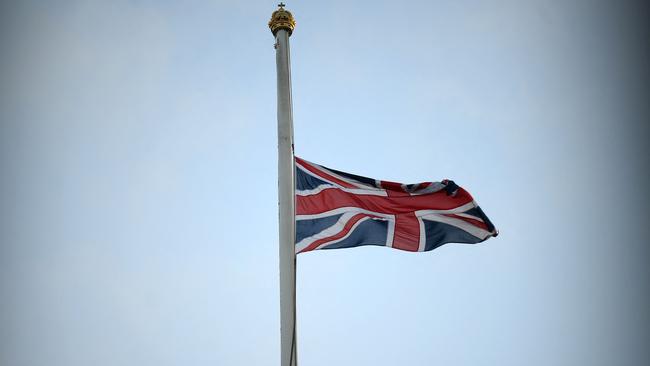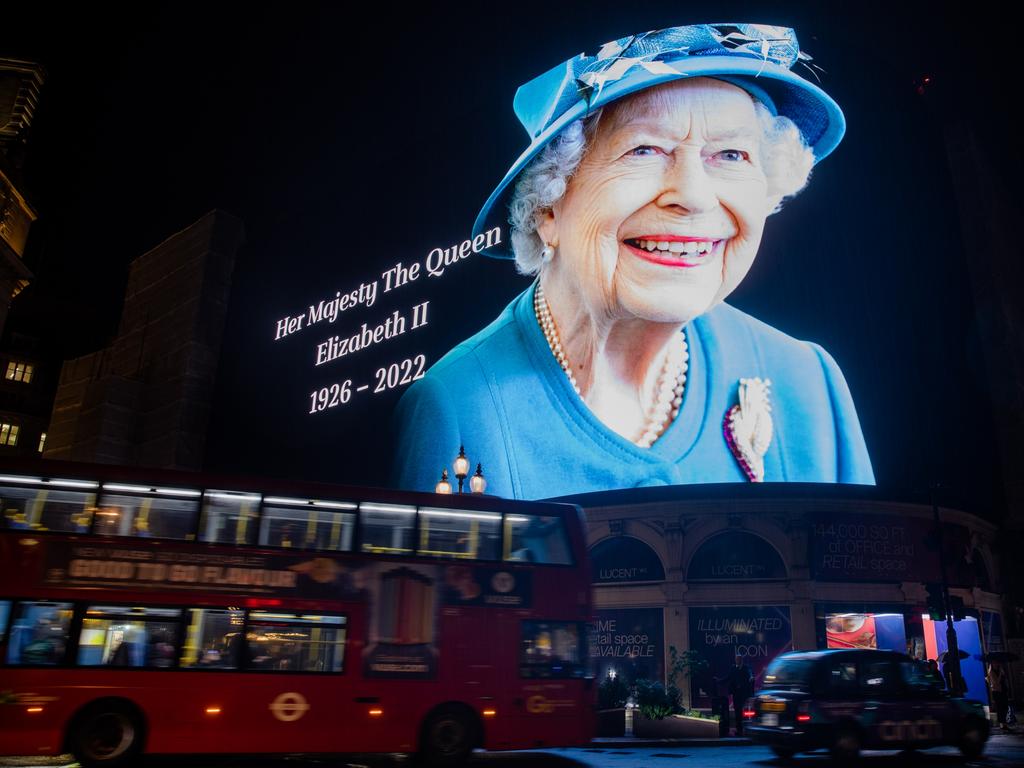The Queen’s passing sets off a series of actions planned for 50 years
Every moment of the next 10 days has been set out in extraordinary detail in plans approved by Queen Elizabeth herself.
Buckingham Palace has been planning for the death of the Queen for half a century. These plans, updated regularly and shared with prime ministers and governors-general, provide for the observance of the Queen’s death, 10 days of official mourning and her state funeral.
The first day of the Queen’s death is designated as “D-Day” and will be followed by 10 further days of official grieving and remembrance, beginning with D+1 through to D+10. This process, known officially as “the demise of the Crown”, is set out in extraordinary detail, leaving nothing to chance.
These top-secret plans, conveyed in writing and verbally to Australian governors-general and prime ministers, were first revealed by The Australian in 2017. They provide the guidebook for what happens in the UK and throughout the Commonwealth.
The Australian component of these plans include: a national day of commemoration possibly to be a public holiday; four official Australian mourners and perhaps a dozen notable Australians being invited to the funeral; and a special meeting of the Executive Council to proclaim Charles III as King of Australia to be read publicly by the Governor-General.
The four official mourners from Australia are likely to be the prime minister, Governor-General and their partner or spouse. The opposition leader is not expected to be among them. The group of Australians are to represent all walks of life, such as indigenous Australians, military leaders and representatives from charitable, religious, sporting and community groups.
In 2022, The Australian revealed that two RAAF planes will pick-up Pacific leaders to transport them to London for the funeral. This is being referred to as “the milk run” and is designed to ease the challenging transport logistics as leaders converge on London. The prime minister and Governor-General will travel in different planes.
Buckingham Palace has several plans for royal funerals that are routinely revised. For hundreds of years, the death of the monarch and the crowning of a new king or queen has been overseen by the Duke of Norfolk in his capacity as Earl Marshal.
These plans are known as “bridges”. The Queen Mother’s plan was Tay Bridge. Prince Philip’s plan was titled Forth Bridge. With the Queen’s death, the words “London Bridge is down” echoed through Buckingham Palace, Whitehall and Number 10.
Buckingham Palace is acutely aware that even though Elizabeth II was long-reigning monarch, her death will cause an immediate and pervasive shock that will be unsettling for many. While there will be a new king, it is appropriate to honour and mourn the deceased monarch.

At the precise moment the Queen breathed her last, the Prince of Wales became Charles III, King of Australia. At that moment Prince William, the Duke of Cambridge, also became the new heir to the throne and the new Prince of Wales.
There are significant ceremonial obligations and legal traditions that must be followed by the Governor-General and the Prime Minister in Australia.
The Inter-Realm Working Group, made up of Buckingham Palace and Clarence House officials, has been in regular contact with Australia. A team in the Department of Prime Minister and Cabinet has been working on the Australian component of the London Bridge plan.
An area of previous dispute was who would make the first formal announcement of the Queen’s death in Australia: the Prime Minister or the Governor-General? Buckingham Palace had a detailed communications plan notifying prime ministers and vice-regal representatives in the Queen’s realms and member states of the Commonwealth, in addition to other foreign leaders. This was likely to have taken place about an hour before the official announcement of the Queen’s death.
There are other protocols in place. Several Australians will be invited to a meeting of the Accession Council, a formal proclamation will be issued in Australia, a title for the new king must be determined by parliament, there is a funeral service to attend abroad and also a memorial service to be arranged at home.

It was planned that the official announcement of the Queen’s death be made from the Buckingham Palace press office and posted on the royal website. A notice is customarily placed on the railings of Buckingham Palace.
The bell at Windsor Castle will toll at 12pm on D-Day or D+1, once per minute for each year of the Queen’s life. At dusk, there will be a gun salute.
The floodlights at Buckingham Palace will be extinguished. Bells will also toll at St Paul’s Cathedral and Westminster Abbey for one hour on D-Day or D+1. Bells will ring at churches across Australia. Guns will be fired periodically over the next 10 days. The Australian Defence Force will organise gun salutes to coincide with events in London. (The ADF will also participate in British ceremonies.)
Condolence books will be opened online and at locations across Britain for the 10 days. A book of condolences will be opened at Parliament House in Canberra. On D+10, Big Ben will strike once at 11am to mark the beginning of two minutes of silence.
Flags will be flown at half-mast across the UK. In Australia, flags will also be half-masted on D-Day and over the following 10 days, except on the day of accession when the new monarch is proclaimed. A flag notice will be issued with these instructions.
One of the most fascinating of ancient rituals is the Accession Council. At 10am on D+1, the Accession Council will meet at St James’s Palace in London to proclaim the new king. It is made up of Privy Counsellors, the Lord Mayor of London and the Court of Aldermen, the Great Officers of State and several senior civil servants.
There are several Australian Privy Counsellors at the time of writing: Sir William Heseltine, the Queen’s former private secretary; Ian Sinclair, a former National Party leader; and Patricia Hewitt, a former British Labour minister. Australia’s high commissioner to London will be invited with other high commissioners to observe the Accession Council.
The signed proclamation announcing the new king will be read from the balcony above Friary Court at St James’s Palace. Below will be an array of Royal Horse Guards, radiant gold carriages, troops with medals shining on their embroidered jackets and officials clad in the finest crimson cloaks, damask silk and white gloves.
The Queen’s coffin will move in procession from Buckingham Palace to Westminster Hall on D+5. Big Ben will toll for each minute during the procession. The lying in state will take four days (D+6, D+7, D+8, D+9). On D+10, there will be a procession to Westminster Abbey for the state funeral at 11am.
The coffin then moves in procession to Wellington Arch and then to St George’s Chapel at Windsor Castle for the committal service in the afternoon. A private burial will take place in the King George VI Memorial Chapel at 7pm.
A national memorial service will be arranged in Australia after the state funeral in the UK.
The Australian proclamation of the King’s accession is ceremonial rather than legal, but it will be formally styled.
In 1952, governor-general Sir William McKell proclaimed the accession from the steps of Parliament House. Current plans state that the Governor-General will issue the Australian proclamation of accession at an appropriate ceremony. State governors may also issue proclamations.
The king’s title will be established by proclamation in the UK. It is expected to be: Charles III, by the Grace of God of the United Kingdom of Great Britain and Northern Ireland and of His other Realms and Territories, King, Head of the Commonwealth, Defender of the Faith.
The Australian proclamation will include the king’s Australian title, but it will have no legal force. Parliament must amend the Royal Style and Titles Act 1973 to establish the king’s Australian title. Consultation will be required with the states, especially Western Australia and South Australia, given their own style and titles laws. The states may need to pass legislation ahead of the Commonwealth.
It is understood by the Australian government that the new king’s Australian title will be: Charles III, by the Grace of God King of Australia and His other Realms and Territories, Head of the Commonwealth.
The title of the king’s second wife, Camilla, Duchess of Cornwall, is reportedly to be Queen Consort.
The demise of the monarch will follow legal traditions and ceremonial customs similar to that followed in the UK and in Australia when George VI died in 1952. But, in this digital age, it will be manifestly different.
In Australia in 1952, the entrances to public buildings were draped in purple and black. Ministers wore black suits and ties for days. Church bells tolled for one hour each day until the funeral, which was designated as a day of mourning. Theatres were asked to close, sporting fixtures were cancelled and schoolchildren proudly sang God Save the Queen.
Even the most meticulous organisation may not go as planned. When George VI died, the media knew before prime minister Robert Menzies. The news came from wire services overseas and was relayed to the nation. Menzies was chairing a cabinet meeting when he learnt the news. He later made the grim announcement to the House of Representatives.
In 1952, the House met for a special but short session to adopt a condolence motion and to hear official speeches of sympathy from Menzies and opposition leader H.V. “Doc” Evatt. The motion was carried by MPs standing in the House. It is expected that parliament will meet for a condolence motion.
It is possible that Charles and William may decide to alter some of these arrangements which were approved by the Queen.
In any event, this will be a grand occasion that follows ancient ritual and custom, as well as legal tradition, and is marked by extraordinary pomp and pageantry.
The next 10 days will honour a deceased Queen and usher in a new age for the House of Windsor with a new king.








To join the conversation, please log in. Don't have an account? Register
Join the conversation, you are commenting as Logout